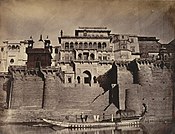Ramnagar Fort
This article may need to be rewritten to comply with Wikipedia's quality standards. (March 2024) |
| Ramnagar Fort | |
|---|---|
| Part of Fort | |
| Site history | |
| Built | 1750 |
| Built by | Balwant Singh |
| Materials | chunar sandstone |
| Garrison information | |
| Occupants | Anant Narayan Singh |
The Ramnagar Fort is a
Geography

The fort is at a scenic location on the eastern right bank of the Ganges River, opposite to the Varanasi Ghats. It is 14 kilometres (8.7 mi) from Varanasi and 2 kilometres (1.2 mi) from the
History
The Ramnagar Fort was built by Kashi Naresh Maharaja Balwant Singh in 1750. Inscriptions on the outer ramparts of the fort date it to the seventeenth century.[3]
Architecture
The building was constructed with creamy-coloured chunar sandstone. The fort houses the Veda Vyasa Temple, a museum, and the king's residential complex.[5] There is also a Dakshin Mukhi temple of Hanuman, which faces towards south.[6]
The fort has been built on high ground, which is above the flood level.[7] The fort has many carved balconies, open courtyards and pavilions.[5] Only a part of the structure is open for public viewing as the rest of it is the residence of Kashi Naresh and his family. The flag on the fort is raised when the Maharaja is in residence in his palace fort.[1] Within the fort, the palace has two white towers, which are accessed by a flight of steps. At the end of the flight of steps, there is an archway and many courtyards that lead to the white tower.[3] The private residence of the Maharaja is on one side of the tower while the Durbar Hall and reception rooms are on the other side. An inscription on the fort wall attests "Fortified House of the Rajah of Benares, with his state Boat".[8]
Museum

The museum is known as Saraswati Bhawan. The museum is in what used to be the
Festivals

The fort palace appears very vibrant and colourful when beatified during the one-month-long
In popular culture
Because of its scenic location on the banks of the Ganges, the fort and the palace are frequently used as an outdoor shooting location for films. The film titled Banaras is one of the popular movies shot here.[1][2] It was the seventh pit stop of The Amazing Race 18.
Gallery
-
Balcony of the fort
-
Balcony
-
Fountain in the courtyard
-
Cannon outside the fort
-
Main entrance
-
Outer wall
-
The fort across the Ganges River
-
Inner Courtyard
-
Painting of the fort c.1796
See also
References
- ^ ISBN 9788187780045. Retrieved 6 November 2012.
- ^ a b c d "Lonely Planet review for Ramnagar Fort & Museum". Lonely Planet. Retrieved 6 November 2012.
- ^ a b c d "Fort, Ramnagar [Benares]". Online Gallery of British Library. Retrieved 7 November 2012.
- ^ "Rambag (Ramnagar) [Benares]". Online Gallery of British Library. Retrieved 7 November 2012.
- ^ a b c d "Ramnagar Fort & Museum". Official Website of Eastern UP Tourism. Archived from the original on 30 November 2013. Retrieved 7 November 2012.
- ^ "Ramnagar". National Informatics Centre. Retrieved 7 November 2012.
- ^ ISBN 978-1-4000-1312-8.
- ^ "The Raja of Benares's palace at Ramnagar from the river, with the Raja's state boat". Online Gallery of British Library. Retrieved 7 November 2012.
- ISBN 978-81-87952-12-1.
- ISBN 9788124603383. Retrieved 7 November 2012.
- ^ ISBN 9788187780045.
- ISBN 9780415343558.
- ^ a b "Ram Leela Mela. As performed before at Ram Nugur before the Raja of Benares". Online Gallery of British Library. Retrieved 7 November 2012.
External links
- Information about Ramnagar Fort Varanasi.
- Ramnagar Fort












